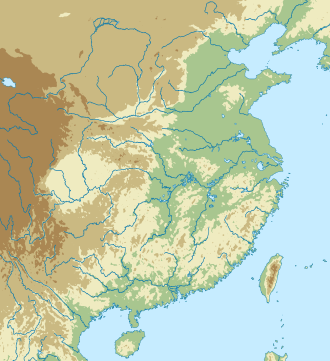
Back بحيرة تاي Arabic بحيره تاى ARZ Тайху Byelorussian Тайху Bulgarian ཐའེ་ཧུའུ་མཚེའུ། Tibetan Llac Taihu Catalan Tchaj-chu Czech Тайху CV Tai Hu Danish Tai Hu German
This article has multiple issues. Please help improve it or discuss these issues on the talk page. (Learn how and when to remove these messages)
|
| Lake Tai | |
|---|---|
| Taihu, T'ai-hu | |
| 太湖 (Chinese) | |
 Lake scenery at Wuxi | |
| Location | southern Jiangsu and northern Zhejiang |
| Coordinates | 31°14′N 120°8′E / 31.233°N 120.133°E |
| Basin countries | China |
| Surface area | 2,250 km2 (869 sq mi) |
| Average depth | 2 m (6.6 ft) |
| Islands | 90 |
| Settlements | Huzhou, Suzhou, Wuxi |
| Lake Tai | |||||||||||
|---|---|---|---|---|---|---|---|---|---|---|---|
| Chinese | 太湖 | ||||||||||
| Literal meaning | Great Lake | ||||||||||
| |||||||||||

Taihu (Chinese: 太湖), also known as Lake Tai or Lake Taihu, is a lake in the Yangtze Delta and the third largest freshwater lake[1] in China. The lake is in Jiangsu province and a significant part of its southern shore forms its border with Zhejiang. With an area of 2,250 square kilometers (869 sq mi) and an average depth of 2 meters (6.6 ft),[2] it is the third-largest freshwater lake entirely in China, after Poyang and Dongting.[a] The lake contains about 90 islands, ranging in size from a few square meters to several square kilometers.
Lake Tai is linked to the Grand Canal and is the origin of a number of rivers, including the Suzhou Creek. The major cities around Taihu Lake include Suzhou, Wuxi, Changzhou and Huzhou. These urban areas form the core of the lake's cultural and economic region.[3] University-led hydrological and ecological studies note that these four cities are the primary urban centers surrounding the lake.[3]
Taihu Lake is officially designated as a national key scenic area under China's Major National Historical and Cultural Sites programme.[4]
- ^ "Lake Tai, China". The European Space Agency. Retrieved March 8, 2025.
- ^ 太湖 [Lake Tai]. The Suzhou Science Window 苏州科普之窗 (in Chinese). Science and Technology Association of Suzhou City [苏州市科学技术协会]. Archived from the original on June 11, 2007.
- ^ a b Zhao, Qingjian; Wang, Qiuyan (2021). "Water Ecosystem Service Quality Evaluation and Value Assessment in Taihu Lake Region". Water. 13 (5): 618. doi:10.3390/w13050618.
- ^ Qin, Boqiang; Zhang, Wei (2014). "The changing environment of Lake Taihu and its ecosystem responses". Lakes & Reservoirs: Research & Management. 30: 1–3. doi:10.1080/02705060.2014.992053. Retrieved June 22, 2025.
Cite error: There are <ref group=lower-alpha> tags or {{efn}} templates on this page, but the references will not show without a {{reflist|group=lower-alpha}} template or {{notelist}} template (see the help page).


